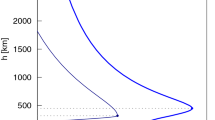Summary
In connection with the problem of optimally combining the results of a global geopotential mission using (1) a gravity gradiometer and (2) an on-board GPS receiver, we propose a technique operating in the frequency domain using “criterion functions”, which describe the precision of each inversion solution as a function of degreen and orderm of its spherical harmonic expansion.
We propose a formalism for term-wise averaging in the frequency domain, which is both unbiased and optimal in a global least-squares sense.
Software for deriving a “criterion function” for the geopotential coefficient recovery errors from both GPS-tracking and gradiometry was developed. This function gives a simple description, using a few parameters only, of the error behaviour of various observation types and geometries.
Criterion functions derived for various simulated missions are described, analytically converted to degree variance functions, and compared with results by others. For one case, criterion function dependence on mission parameters is studied.
Similar content being viewed by others
References
Abramowitz, M, Stegun IA (1970) Handbook of Mathematical Functions. Dover, New York 1970.
Baarda W (1973) S-Transformations and Criterion Matrices. Neth. Geod. Comm. Publ. on Geodesy, New Series, Vol.5 No.1, Delft.
Colombo OL (1981) Numerical methods for harmonic analysis on the sphere. Report 310, Ohio State Univ., Dept. of Geodetic Science and Surveying, Columbus OH.
Colombo OL (1984) The Global Mapping of Gravity by Two Satellites. Neth. Geod. Commission Publ. on Geodesy, New Series, Vol. 7 No. 3, Delft.
Haagmans RHN, Van Gelderen M (1991): Error variances-Covariances of GEM-T1: Their Characteristics and Implications in Geoid Computation.JGR 96, B12 20 011–20 022.
Koop RJJ (1993) Global gravity field modelling using satellite gravity gradiometry. Ph.D. thesis, Delft Univ. of Technology, Fac. of Geodetic Engineering.
Lerch FJ (1991) Optimum data weighting and error calibration for estimation of gravitational parameters,Bulletin Géodésique 65, 44–52.
Rapp RH, Cruz JY (1986) Spherical Harmonic Expansions of the Earth's Gravitational Potential to Degree 360 Using 30′ Mean Anomalies. Report 376, Ohio State Univ., Dept. of Geodetic Science and Surveying, Columbus OH.
Schrama EJO (1989) The role of orbit errors in processing of satellite altimeter data. Ph.D. thesis, Delft Univ. of Technology, Fac. of Geodetic Engineering.
Schrama EJO (1991) Gravity Field Error Analysis: Applications of Global Positioning System Receivers and Gradiometers on Low Orbiting Platforms.JGR 96, B12, 20 0141–20 051.
Sjöberg LE (1981) Least squares combination of satellite and terrestrial data in physical geodesy.Ann. Géophys., t.37, fasc.1, 25–30.
Tscherning CC, Rapp RH (1974) Closed Covariance Expresssions for Gravity Anomalies, Geoid Undulations, and Deflections of the Vertical Implied by Anomaly Degree Variance Models. Reports of the Department of Geodetic Science No. 208, The Ohio State University.
Tscheming CC, Vermeer M, Forsberg R (1990) Methods for regional gravity field modelling from SST and SGG data. Finnish Geodetic Institute, Report 90:2, Helsinki.
Van Gelderen M, Haagmans RHN (1990) The GEMT1 Variance-Covariance Matrix: Its Characteristics and Applications in Geoid Computations. In: Determination of the Geoid, Present and Future. Proc. Milan Geoid Meeting, Ed. R.H.Rapp and F. Sansó, Springer Verlag.
Vermeer M (1989) FGI Studies on Satellite Gravity Gradiometry. 1. Experiments with a 5-degree buried masses grid representation. Finnish Geodetic Institute, Report 89:3, Helsinki.
Vermeer M (1990) FGI Studies on Satellite Gravity Gradiometry. 2. Geopotential recovery at 0°.5 resolution from global satellite gradiometry data sets. Finnish Geodetic Institute, Report 90:1, Helsinki.
Vermeer M (1992) FGI Studies on Satellite Gravity Gradiometry. 3. Regional high resolution geopotential recovery in geographical coordinates using a Taylor expansion FFT technique. Finnish Geodetic Institute, Report 92:1, Helsinki.
Vermeer M, Forsberg R (1992) A generalised Strang van Hees approach to fast geopotential inversion.Manuscipta geodaetica 17, 302–314.
Visser PNAM (1992) The Use of Satellites in Gravity Field Determination and Model Adjustment. Delft University Press, Delft.
Wenzel, H-G (1981) Zur Geoidbestimmung durch Combination von Schwereanomalien und einem Kugelfunktionsmodell mit Hilfe von Integrationsformeln.ZfV 3/1981, 102–111.
Wichiencharoen C (1984) A comparison of gravimetric undulations computed by the modified Molodensky truncation method and the method of least squares spectral combination by optimal integral kemels.Bull Géod. 58 494–509.
Author information
Authors and Affiliations
Rights and permissions
About this article
Cite this article
Vermeer, M. Some simulated noise inversion studies of satellite geopotential missions involving “criterion functions” in the frequency domain. Journal of Geodesy 70, 397–409 (1996). https://doi.org/10.1007/BF01090815
Issue Date:
DOI: https://doi.org/10.1007/BF01090815




